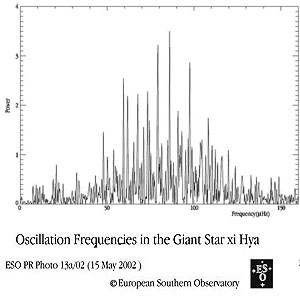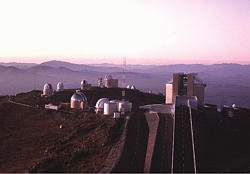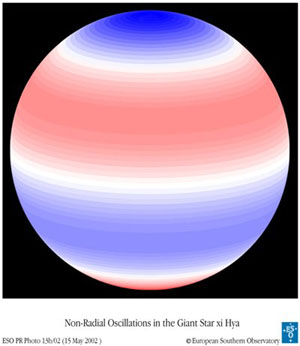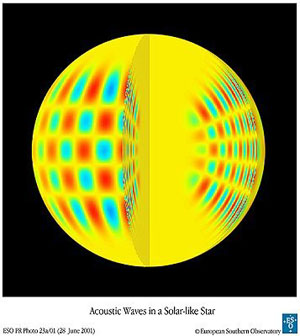A new member of the stellar orchestra has been identified by astronomers and the star, xi Hya in the constellation of hydra 130 light-years away, plays a very different tune to our own star, the Sun.
The Sun resonates like a giant, spherical organ pipe. It produces well-defined notes although they are far too deep to be seriously described as music. The energy that produces these enormous waves of sound comes from the turbulent region just below the Sun’s visible surface. Solar scientists have been studying these sound waves with the art of helioseismology for about thirty years. As with the Earth’s own vibrations before and after an earthquake, the researchers can use the frequency and movement of the waves to indirectly explore the Sun’s interior.

Oscillation frequencies
Astronomers are now tuning into the pitch of stars elsewhere in the heavens and have applied the general variation on the theme – asteroseismology – to stars that resemble the sun. The first observations of a star very different from the sun have been made on xi Hya also known rather enigmatically as CD-31 9083 among some audiences.
An international team of astronomers has observed xi Hya with the Swiss 1.2 metre Euler telescope at the European Southern Observatory’s La Silla Observatory, in Chile, and discovered that the star behaves like a giant sub-ultra-bass instrument. Xi Hya is twenty times the diameter of our Sun and is about 60 times more luminous; it is also, sadly close to retirement from the firmament, so a very different instrument indeed. The team has measured the timbre of xi Hya and found that it oscillates with several periods of around 3 hours.

Views of the ESO La Silla Observatory
It is estimated that the star’s outer envelope will soon, within hundreds of thousands of years, anyway, expand and the star will take on the stature of a red giant. Asteroseismology hopes to become the scientific method of choice for reading the underlying score of such changes and providing a more detailed understanding of stellar interiors and the overall evolution of stars.

View of the ESO La Silla Observatory (2)
The team led by Conny Aerts of the Catholic University of Leuven, in Belgium, Soeren Frandsen of the University of Aarhus in Denmark, and Fabien Carrier of the Geneva Observatory in Sauverny, Switzerland and their colleagues used the telescope’s CORALIE spectrograph to measure the oscillation velocities of the stellar surface.

Soeren Frandsen
xi Hya is a giant star so the waves need more time to propagate through from deep within the star but the surface reveals a broad distribution of about a dozen different frequency sound waves. The team point out that it is more difficult to model the interior of a giant star than our familiar sun because the giant’s core has changed a lot during its evolution. The sound waves in the sun are mostly concentrated in the outer parts of the Sun but for xi Hya there are also gravity modes to take into account deep in the interior of the star.

Non-radial oscillations
The team is planning to use the CORALIE and the, soon to be installed, HARPS instruments to listen to the sound show of other stars at different stages in their evolution from those still tuning up to the middle-aged virtuosi.

Acoustic waves in a Solar-like star
The researchers have taken the bold step of announcing their results ahead of publication in Astronomy & Astrophysics Letters. We oppose that researchers keep their results for a long time before informing the press, hence we have given our first results free for the ESO publication relations office to give an example that this [technique] is feasible, Aerts told Spotlight, It is a little risky for us, but I do not like the chase for high impact factors and citations.
The MP3 file linked below raises the pitch of xi Hya’s voice 1 million-fold revealing what some have described as the thundering approach of the Four Horsemen of the Apocalypse rather than the music of the spheres.
Further reading
European Southern Observatory’s La Silla Observatory
http://www.eso.org/sci/facilities/lasilla/
Conny Aerts
http://www.ster.kuleuven.ac.be/~conny/mons/mons.html
Soeren Frandsen
http://www.phys.au.dk/~srf/
MP3 file
http://www.psigate.ac.uk/spotlight/images/PSI4-stellarsound.mp3
Suggested searches
Asteroseismology
Helioseismology
Stellar evolution